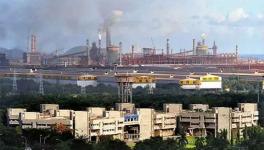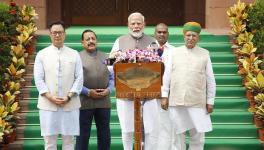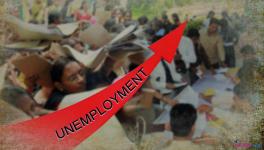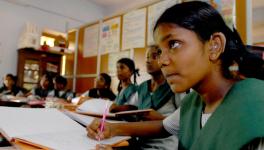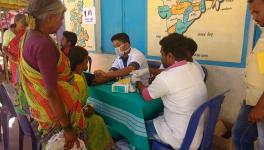Increase in Budget Allocation for Healthcare Not Enough

Representational Image. Image Courtesy: Hindustan Times
The maiden budget speech of Finance Minister Nirmala Sitharaman hardly mentioned the health sector of the country. She did not even touch upon the flagship schemes of the Narendra Modi government. Instead, she only made a passing reference to the sector in her speech.
Sitharaman said that according to the vision presented in the interim budget, a healthy society would remain an area of attention for the current government, which she attributed to schemes like Ayushman Bharat.
The health outlay for this financial year saw an increase of around 19% over the fiscal year 2018-2019, when it was Rs 52,800 crore. The budgetary allocation for the sector has been set at Rs 60,908.22 crore. The budgetary allocation for the Department of Health and Family Welfare has been increased by 15% to Rs 62,659 crore from the revised estimate for 2018-2019. During the previous budget, the allocation for National Rural Health Mission (NHRM) had been decreased. However, the amount has been increased by 7.11% this time, with the allocation being fixed at Rs 27,039 crore.
There are doubts as to whether this increase would be enough to improve the rural health infrastructure across the country. According to the Economic Survey tabled in the Parliament on July 4, the rural health infrastructure is in a poor condition. According to the Survey, 60% of the primary health centres (PHCs) in India have only one doctor, while 5% have none. The Survey also stated that only 20% of the existing PHCs fulfil Indian Public Health Standard norms, and there is an acute shortage of human resource in these peripheral health institutions.
According to the Economic Survey, Gujarat has emerged as the worst performer with respect to the condition of PHCs, with more than 90% of the centres having just one doctor. The survey also stated that more than 10% of the PHCs in Jharkhand and over 20% in Chhattisgarh function without doctors. “States with large number of PHCs functioning with just one doctor or without a doctor are indicative of relatively higher rural Infant mortality rates (IMR) and maternal mortality ratio (MMR),” said the Survey.
It added that besides the lack of doctors, participation of healthcare staff was also found to be disturbing. The Survey stated, “What this data does not reveal is that even if the personnel are present, their level of participation in providing health services, may not be at desirable levels due to lack of supplies, inadequate infrastructure facilities, poor monitoring of the staff.”
As revealed by the Survey, the allocation on healthcare as a percentage of the gross domestic product (GDP) remained at 1.5%. Out-of-pocket expenditure (OOPE) by the patients is still worrisome — one of the highest in the world, despite a decline in the last few years. The Survey identified cost of medicines as one of the major contributors to OOPE. This reveals that despite several schemes of the government to provide free drugs, including the Jan Aushadhi Yojana, the situation has not changed much in reality.
The survey conceded that while there are “various provisions to provide medicines free of cost, but in reality, a majority (more than 60 per cent) of the patients are still forced to pay.”
The budget allocation for the National Urban Health Mission has also been increased to Rs 950 crore from the previous Rs 875 crores. However, this year’s budget makes clear that even though the primary healthcare needs the most attention, the government is focusing more on the tertiary care programmes. The tertiary programmes saw the highest increase among all components of the health sector’s budget.
Another important component where the allocation has been decreased is the upgradation of district hospitals to medical colleges. Against the revised estimates of the previous year, the allocation has been reduced by 36% to Rs 2,000 crore. This is a significant decrease because the government had recently announced that it would convert another 75 district colleges to medical colleges and hospitals. This promise was also a part of the Bharatiya Janata Party’s manifesto in the recently concluded general elections.
The allocation for ‘Upgradation/Strengthening of Nursing Services (Auxiliary Nurse Midwives (ANMs)/General Nurse Midwives (GNMs)’ has also gone down from Rs 66 crore (2018-19 budget estimate) to Rs 64 crore (2019-20 revised estimate).
Rs 6,400 crore earmarked for the Centre's flagship health insurance scheme Ayushman Bharat – Pradhan Mantri Jan Arogya Yojna (AB-PMJAY). According to the Jan Swasthya Abhiyan (JSA), the scheme that works on an insurance-based model of healthcare comes at a huge and disastrous cost of the public provisioning of health.
“If the insurance is scaled up in a context where there is a huge inadequacy and inequity in access and no proper regulation, it would result largely in transfer of public funds into private hands without any matching health outcomes or financial protection. The current government remains adamant on expanding the scheme,” said a JSA leader to NewsClick.
Get the latest reports & analysis with people's perspective on Protests, movements & deep analytical videos, discussions of the current affairs in your Telegram app. Subscribe to NewsClick's Telegram channel & get Real-Time updates on stories, as they get published on our website.












